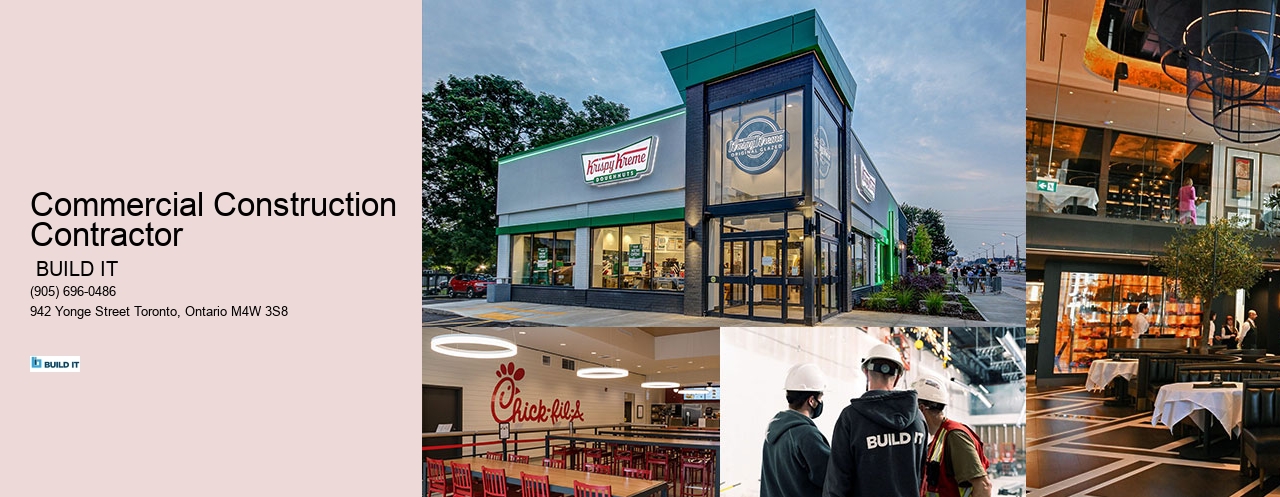

| Commercial Construction Services | |
|---|---|
| Commercial Builder | Experienced builder for all types of commercial projects. |
| Commercial Construction | Full-service construction for office, retail, and industrial spaces. |
| General Contractor Commercial Construction | End-to-end general contracting services for commercial sites. |
| Design Build Commercial Contractors | Integrated design and construction services for streamlined delivery. |
| Commercial Tenant Improvement Contractors | Custom interior build-outs and renovations for tenants and landlords. |
BUILD IT Toronto is proud to shape the spaces where Toronto works, shops, dines, and grows. As commercial and industrial construction specialists, we partner with Canada’s leading brands and entrepreneurs to deliver tailored builds that meet the highest standards of quality, precision, and innovation. Whether it’s a boutique on Queen West, a clinic in North York, or a warehouse in Scarborough, we bring your ideas to life—efficiently and beautifully.
Unlike traditional contractors, we offer full-spectrum service. From the earliest planning stages and permit coordination to design-build management and project delivery, we handle it all in-house. This integrated approach means fewer delays, better accountability, and a smoother client experience.
We know Toronto. Our seasoned team knows how to navigate the city’s zoning laws, work within tight urban footprints, and meet aggressive timelines. Across the GTA—including Mississauga, Vaughan, Etobicoke, and the downtown core—we’ve successfully completed projects that stand as proof of our dedication to detail and quality.
From restaurants and retail to healthcare and franchises, we build spaces that balance form, function, and compliance. Every project is designed with usability, longevity, and brand identity in mind.
At BUILD IT Toronto, we value our clients as true partners. Through open communication and smart scheduling tools, we provide clarity every step of the way. Because to us, transparency is just as important as craftsmanship.
When your physical space plays a vital role in your business success, choose a team that builds with intention. Let’s create a space that reflects your vision—and supports your future.

The successful closure of a commercial construction project hinges on the pre-established criteria that define completion. These benchmarks often include meeting the specifications detailed in the contract, passing all required inspections, and obtaining necessary occupancy permits. Commercial contractors must ensure that all aspects of the building meet or exceed the standards set forth by local regulations and client expectations.
A crucial step towards project close-out is undergoing final inspections. This process involves local authorities and possibly third-party inspectors reviewing the construction work to confirm it adheres to codes and zoning laws. Additionally, approvals are needed for systems such as electrical, plumbing, fire safety, and HVAC. Once these inspections are passed successfully, certificates of occupancy can be issued – a green light signifying the project's readiness for use.
Punch lists itemize work that has not been completed or requires correction before final handover. Contractors must address each point diligently; this may involve minor repairs, cleaning tasks, or finishing touches that ensure every aspect of the project meets contracted terms. The goal is to resolve all issues so that nothing impedes final acceptance by the client.
Upon fulfillment of physical construction tasks comes documentation turnover. Contractors provide clients with critical documents including warranties, operation manuals, as-built drawings, maintenance guides, and any other materials relevant to future building management. Proper documentation ensures smooth transition from construction to operation phases.
With construction complete and documentation handed over, attention turns toward financial settlements. Final invoices are issued for any remaining balances on contracts; lien waivers are collected from subcontractors to protect clients against future claims. It’s essential that all accounts be settled properly to avoid legal complications post-project closure.
Finally, a retrospective meeting provides an opportunity for both contractor teams and clients to reflect on what went well during the project lifecycle as well as areas needing improvement in future endeavors. Lessons learned can then be documented for continuous improvement in processes—culminating in better efficiency and client satisfaction in subsequent commercial construction projects.
Before diving into a commercial construction project, it is crucial for clients to grasp the various cost components that form their budget. This includes direct costs such as labor, materials, equipment, and subcontractor expenses. Indirect costs must also be considered; these can include administrative fees, legal services, insurance premiums, and safety compliance expenditures. Understanding these elements helps in creating a comprehensive financial plan that accommodates all possible expenses.
Formulating a realistic budget requires clients to not only consider immediate costs but also account for contingencies and potential overruns. A rule of thumb is to allocate an additional 5-10% of the total projected costs for unforeseen circumstances. This financial cushion ensures that the project can continue smoothly even when unexpected issues arise. Clients should work with experienced contractors who can provide accurate estimates and help set expectations based on industry standards and past projects.
Timelines are closely tied to budgeting as delays often translate into increased costs. It's imperative for clients to understand the project timeline and how it impacts their budget. Overseeing the scheduling of tasks and ensuring milestones are met on time can prevent cost escalations due to overtime charges or extended equipment rentals. Clear communication between clients and contractors regarding deadlines is essential in keeping the project within its financial confines.
Once a construction project kicks off, active budget management becomes key. Monitoring expenditures against the allocated budget should be an ongoing process throughout construction phases. Clients should hold regular meetings with their contractor to review financial reports, discuss cost-saving options if necessary, and make adjustments according to project progress or market changes in pricing of materials or labor rates. Active involvement helps prevent overspending and ensures that funds are used efficiently towards successful completion of the commercial construction endeavor.

Expect demolition (if needed), framing, MEP systems, finishes, inspections, and a certificate of occupancy.
They oversee architectural design, engineering, budgeting, permitting, and manage the build from concept to completion.
They use scheduling software, coordinate subcontractors, plan for delays, and manage milestones.